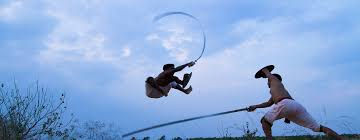African Martial Arts: Engolo
- Amir Hamza
- Jul 4, 2020
- 3 min read
Return to Western African but this time somewhere southwards. We have the West African Nation Angola where the art of Engolo originates. This style stands out to the other African martial arts due to its similarities to its descendant arts across the Atlantic like Capoeira and Juego de Mani as well as a revival movement for Neo-Ngolo that maybe modernising the style for more competitive uses.

Martial Art: Engolo/N'Golo
Style: Striking (Kicking)
Country: Angola (West African)
Origin: Cunene River, Angola (by various ethnic groups)
History: Not much is known about Engolo origins in terms of the earliest records of when it started or began. It is known to be very unique among many African styles due to its similarity to 2 other martial arts in the Americas: one being Juego de Mani (Cuban) and Capoeira (Brazilian), the latter style is probably the better known style among fighting game fans and martial arts enthusiasts due to the presence of Capoeira used by characters like: Tekken's Eddy Gordo, Christie Monteiro and Tiger Jackson. During the 1960s, Angolan Neves e Souza stated Engolo is Capoeira. The similarities between these three styles are not coincidence, in fact Juego de Mani and Capoeira are descended from Engolo past down by Kikongo-Angolan slaves during the Atlantic Slave Trade. Unlike Black Americans who were usually descended from British territories in Africa like Nigeria for example. Black Latinos were usually descended from Portuguese and Spanish colonised areas in Africa such as Angola and Congo. Many African Latinos attempted to preserve their heritage as much as possible leading to disguising their Engolo martial art in more of a dance form hence its evolution into the modern styles of Capoeira and Juego de Mai (also called Baile De Mani or just Mani).

Culture: The name Engolo is believed to originate from the Kikongo word meaning "strength" or "power". This was a ritual combat practiced in southern Angola by the Cunene River. Sousa described the style being used as a rite of passage for Omuhelo: young men fighting to win the honour of a bride in contest. research carried out by Dr.TJ Desch Obi found it is not restricted to one ritual. In his book "Fighting for Honor" and article "Combat and Crossing of the Kalunga", Desch Obi draws parallels between the circle space used in Engolo and inverted techniques with Kalunga Cosmology. The spirit and living worlds are opposite, humans walk on feet, spirits float by hand. Humans are black (solid and opaque, light and matter does not pass through them), Spirits are white (transparent and Intangible ghost like). Humans physical peak is reach in Life, but spiritual peak is reached after death.
Warriors: Much like Capoeira and Mani. Engolo has a strong focus on kicks, sweeps, dodges and inverted positions (Upside down, one or two hands on the floor). It is believed the inverted and kicking technique may be derived from imitating Zebra and how they kick or stomp a predator for protection if they fail to outrun them. Throughout history, many Angolan ethnic groups are said to have a zebra logo or where a zebra belt while playing in the Roda. In recent years there has been revival and modernisations of Engolo by Kenyan-American martial artist Khalil Maasi usually dubbed as Neo-Ngolo where the practitioners use aspects of Capoeira Angola and other mixed styles

Media/Potential: Yet again Chadwick Boseman stated that his trainer Marrese Crump had him also learn Capoeira for the role of Black Panther but specifically Capoeira Angola. This specific style is believed to be the closest to preserving and representing the Angola's original Engolo style, so it makes sense T'Challa's style would resemble this variation. Fighting Games haven't had a diverse number of African Fighters but Street Fighter's Elena uses Capoeira as her style. This could be a reference to Engolo if it was not for the fact Elena is Kenyan (East African) rather than Angolan (West African). We have pointed out how American martial artist Khalil Maasi is adapting Neo-Ngolo for the modern world and he is actually of Kenyan descent. But in theory Fighting Games easily add an Angolan Engolo fighter to represent another stylish African martial art. Here's a lil combo video of Street Fighter Elena who was at the time, Street Fighter's Only African character up until Menat's introduction in Street Fighter V. We also have some of Khalil Maasi training with a mix of Wing Chun to his New Neo-Ngolo fighting style.



Comments